Air Operations, CBI - Making their first use of dive-bombing techniques, 23rd Fighter Group P-40s raid a Hong Kong power station and the airfield at Canton.
- As many as 50 Japanese aircraft attack US airfields in the Assam region, especially the airfield at Sookerating. A freight depot is leveled, but no aircraft are destroyed or damaged. 2 Japanese aircraft are shot down by antiaircraft fire.
- A 51st Fighter Group P-40 downs a Japanese Army reconnaissance plane near Dinjan at 0930 hours and another P-40 downs a Japanese fighter near Digbol at 1220 hours.
[  | |   ] ]
Air Operations, Egypt 18 12th Medium Bomb Group B-25s, escorted by 57th Fighter Group P-20s, attack tactical targets in support of the British 8th Army's El Alamein offensive.
[  | |   ] ]
Air Operations, Europe
BOMBER COMMAND
Evening Ops:
- 24 Stirlings and Wellingtons of 3 Group lay mines in the Frisians and off the Biscay ports.
[  | |   ] ]
Air Operations, Libya After being grounded by bad weather for a week, more than 30 USAMEAF B-17s and B-24s attack Tobruk-bound Axis convoys at sea off the Libyan coast.
[  | |   ] ]
Battle of El Alamein The Australian 9th Div launches its attack in the north; the switch forces the Germans to move their reserves some way to the north. The British action, however, has slowed considerably compared with the first couple of days. Montgomery halts most of his forces to regroup and summons his generals urging them to resume the advance with the determination of the first few hours. In London they are waiting for decisive news, which does not arrive. Churchill is furious, and is said to have exclaimed: 'Is it really impossible to find a general who can win a battle?' The main events of the day are German counterattacks. Rommel orders up 21st Pzr and Ariete from the south. Believing that the main Allied attack is now coming along the coast, he tries to counter there with 15th Pzr and moves 90th Light forward to support.
[  | |   ] ]
Britain, Home Front Another convoy sails for North Africa as part of Operation TORCH.
[  | |   ] ]
Eastern Front In the Caucasus the town of Nalchik, southeast of Pyatigorsk, falls to the Germans. 4 Soviet divisions are being threatened by the attacks of III Pzr Corps here.
SOUTHERN SECTOR
Chuikov ferries the 45th Rifle Division over the Volga to deploy between the Red October and Barrikady factories.
Nalchik falls to elements of the 13th Panzer and 2nd Rumanian Mountain Divisions.
[  | |   ] ]
Battle of Santa Cruz Both sides launch strikes about 7:00a.m. Just after 9:00a.m. the Japanese attack reaches and seriously damages the Hornet (CV-8) which sinks later. The American attacks have been launched at the extreme range of the aircraft, the Japanese having the longer range, and so no fuel can be used forming up for a coordinated attack. Some of the American planes attack Adm Hiroaki Abe's Vanguard Group, damaging the cruiser Chikuma, and the remainder inflict severe punishment on Shokaku. A second wave of Japanese attacks manages to severely damage the Enterprise (CV-6), but many aircraft from this group and from a third less successful strike from Junyo are shot down by the massive barrage of the South Dakota (BB-57). Although the Enterprise (CV-6) is made partially effective, Kinkaid decides to withdraw.
Although this has been an undoubted Japanese victory, leaving the damaged Enterprise (CV-6) as the only American carrier in the Pacific, the Japanese losses in aircrew have again been severe, with the undamaged Zuikaku virtually out of action because of this. The Japanese withdraw also, partly because of lack of fuel, and partly because their aircraft strength has been too reduced to make any attack on Henderson Field worthwhile.[MORE]
Crippled Japanese Dive Bomber Aims for the Hornet
|
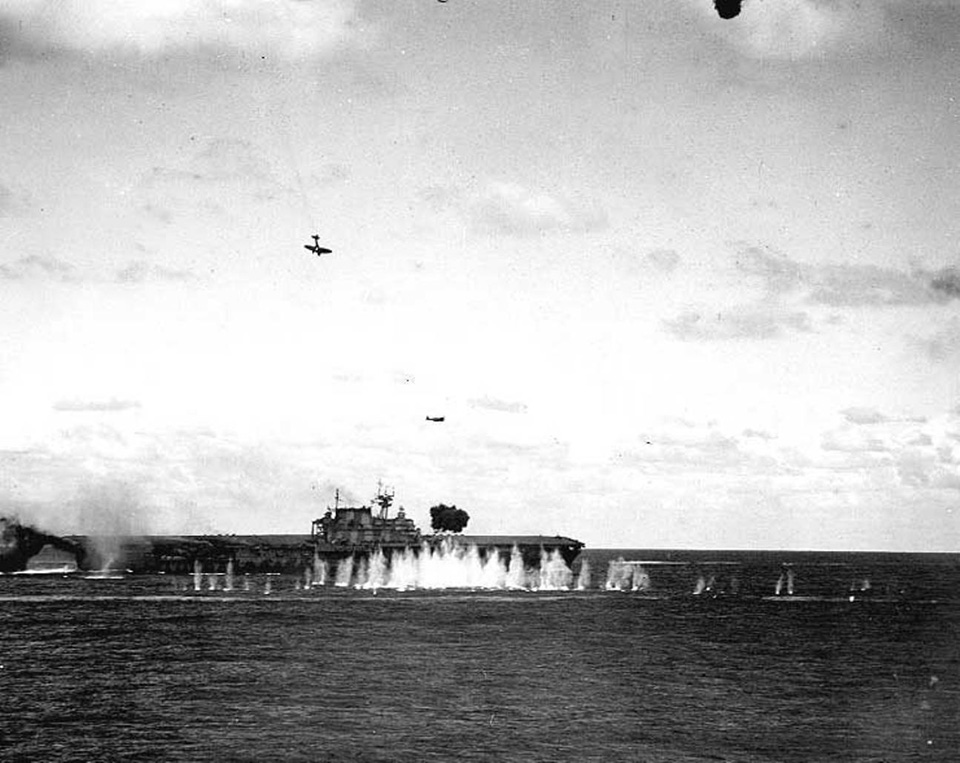 |
|
Japanese Fleet Carrier Shokaku
|
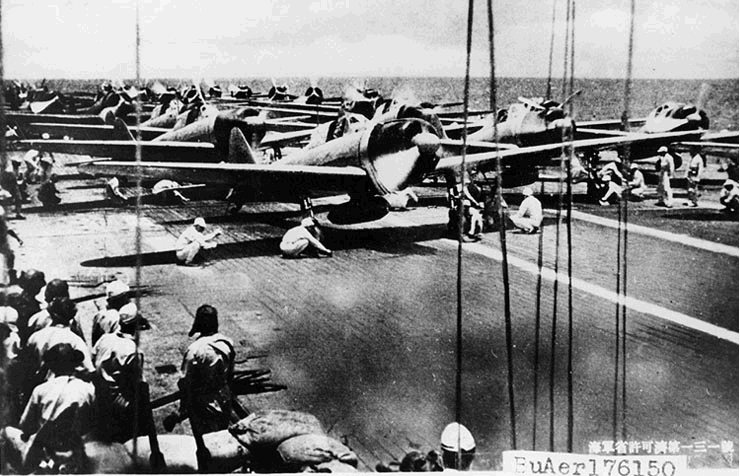 |
|
US Carrier Enterprise
|
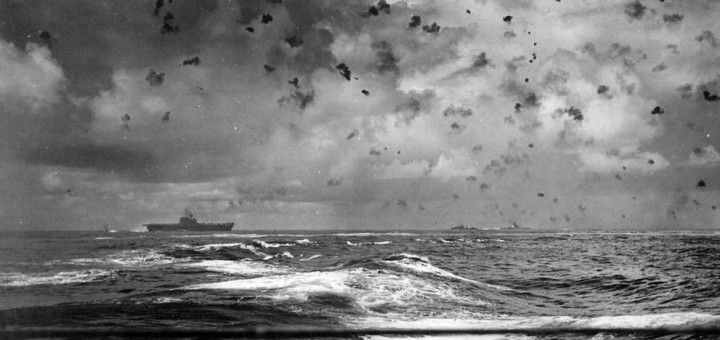 |
|
Japanese Torpedo Plane and US Battleship South Dakota
|
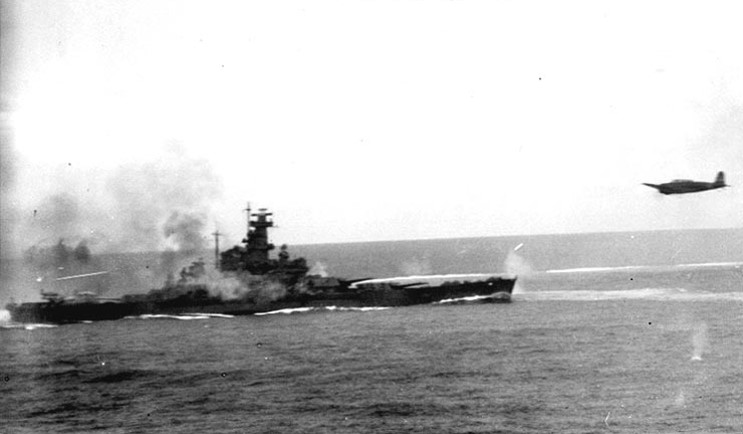 |
|
USS South Dakota (BB-57)
|
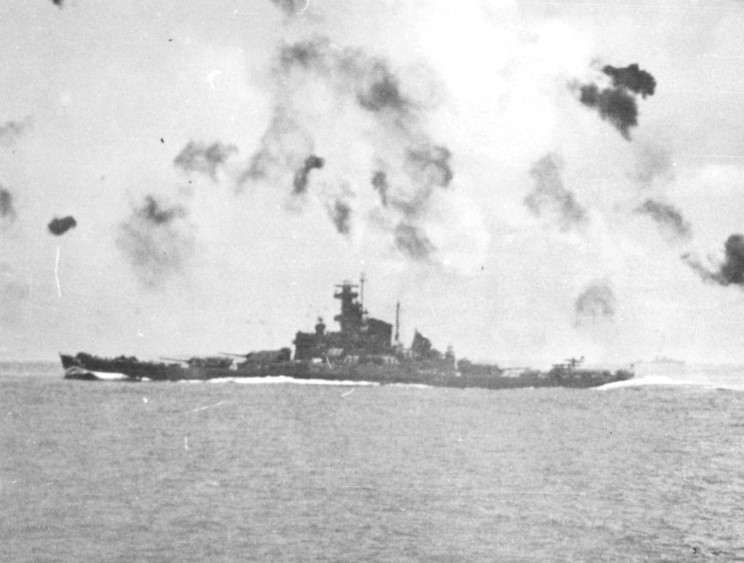 |
|
The Hornet Under Attack
|
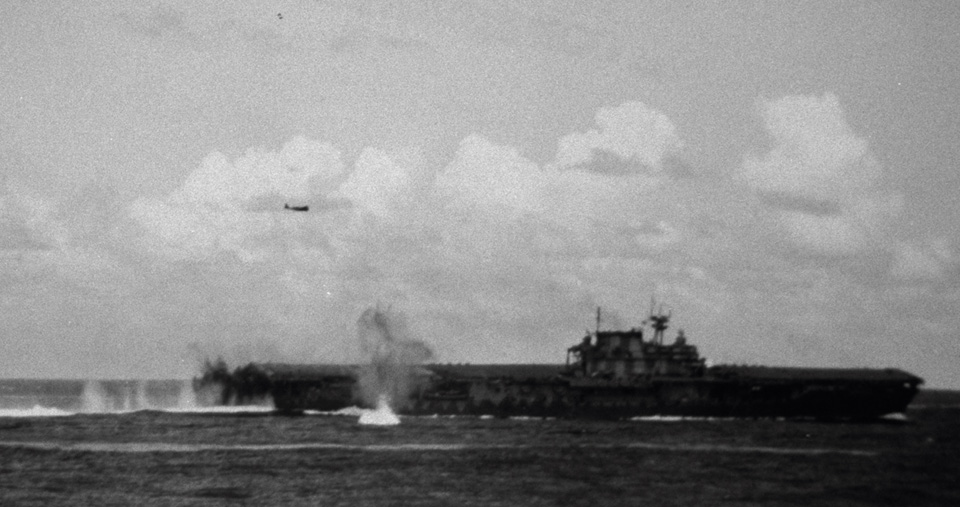 |
|
Japanese Bomber Diving into the Hornet
|
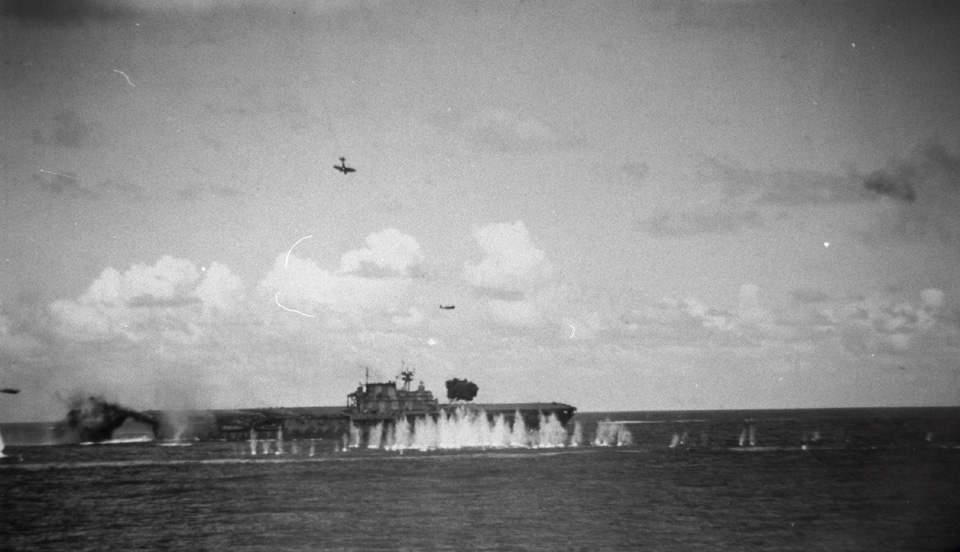 |
|
Japanese Bomber Crashing into the Stack of the Hornet
|
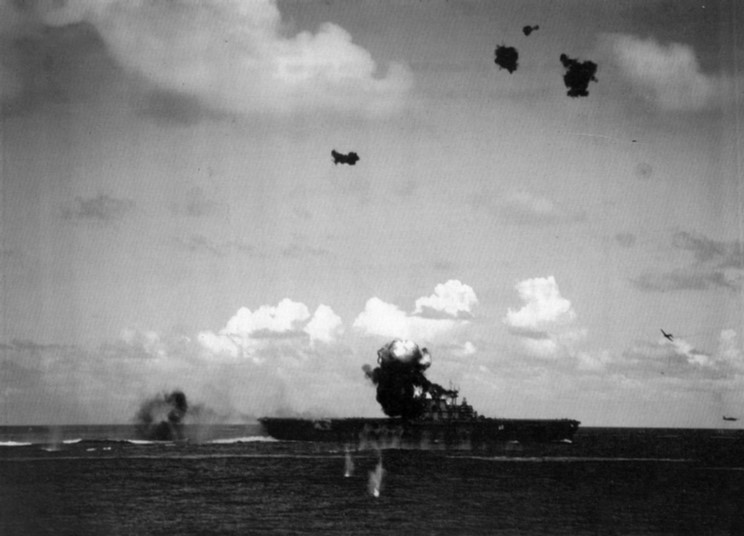 |
|
The Hornet On Fire
|
 |
|
USS Hornet (CV-8) Burning after Japanese Attack
|
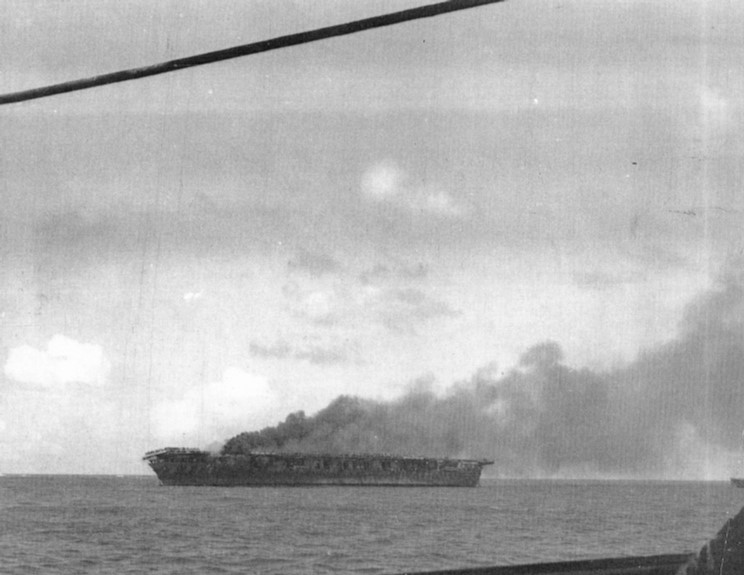 |
|
Hornet with Destroyers Morris and Russell
|
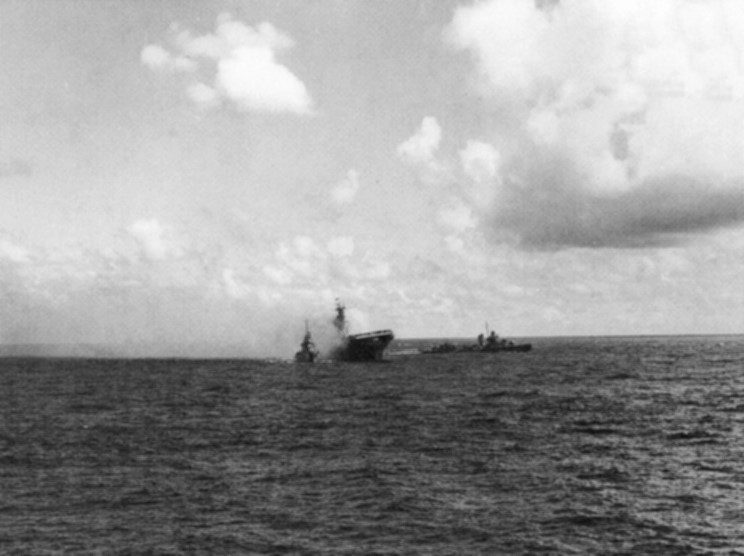 |
|
Another Attack on the Hornet
|
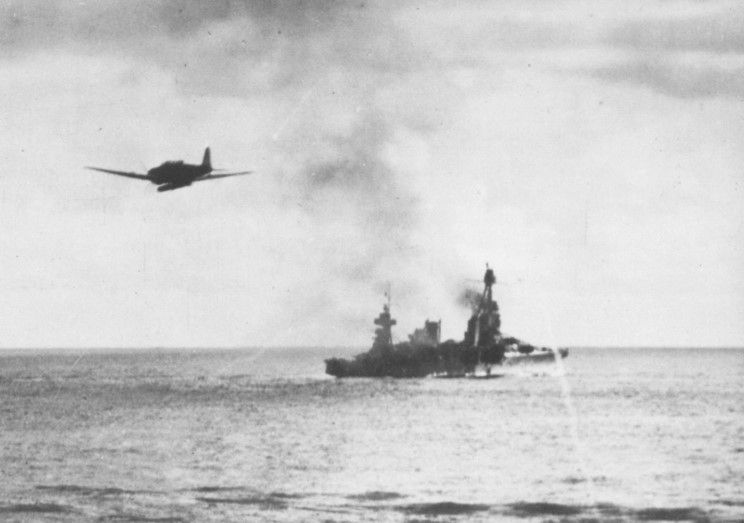 |
|
The Severely Damaged Hornet
|
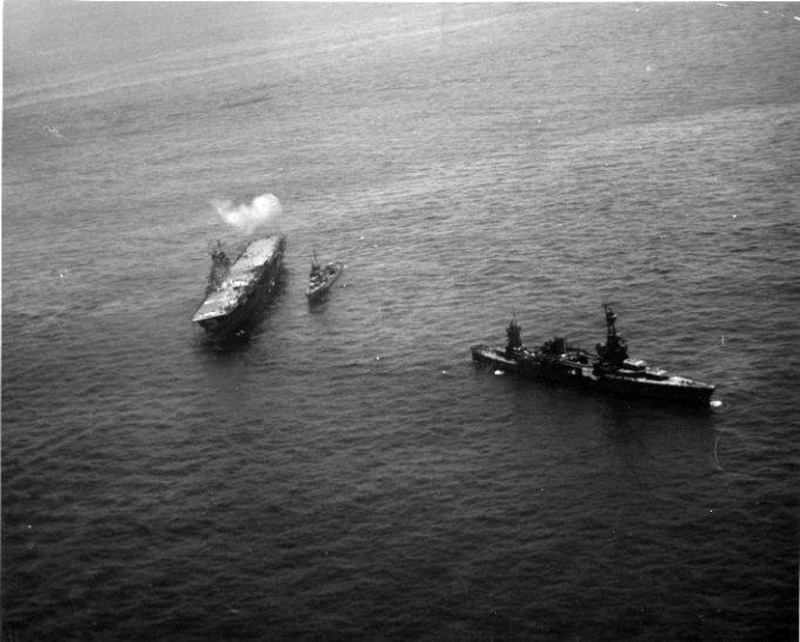 |
[ | |  ] ]
Guadalcanal The Japanese troops, commanded by Gen Kiyotaki Kawaguchi(Gen Maruyama Wave?), renew their attacks but once again are driven off. The marines enlist fighting support in the form of cooks and headquarters personnel who brave the hill with hand grenades and recapture it. The Japanese guns are silenced to a great extent by accurate fire from American batteries.
Adm Kurita sends a reconnaissance plane escorted by 8 Zeros to check out the report that Henderson Field is in Japanese hands. No planes rise in the air to meet them but not for the reason they expected. The fighter runway is unusable after two days of rain. Several hours of baking sun are needed to dry out the mud. The reconnaissance plane is hit by AA fire and explodes into the ground. 5 F4Fs take off about two hours later. Several Zeros are shot down. Takama's destroyers stop off at Lunga Point to destroy the tug Seminole and a small patrol boat enlisted to carry gasoline. Two old four-stack destroyers carrying supplies are nearly caught but manage to escape under cover of air attack against Takama's ships by handful of fighters from Henderson. The ships are also fired at by marine shore guns and 1 5-in gun puts 3 shells into one destroyer and they move away from the shore.
In Adm Kusaka's mind the airfield is held by the Japanese and at noon he contiues to send Zeros to land at field. They engage the Americans as they take off and land. The attrition rate is high on both sides. 5 dive bombers take off at noon to attack Japanese ships in The Slot. They find 3 destroyers, then Takama's flagship, the light cruiser Yura and 5 more destroyers. They attack and 1 1,000-lb bomb hits the Yura squarely in the after engine room which slows the ship's speed to a crawl. The destroyer Akizuki is hit by a bomb and is damaged. The Japanese ships turn to escape. More planes come and score near misses that adds to the damage already inflicted. The captain of the Yura tries to beach his ship near Santa Isabel Island, which is in Japanese hands, but he is caught by planes from Henderson and then by 6 B-17s. The several near misses and bomb hits are too much and the ship begins burning from end to end. The crew abandons ship and it is sunk by 2 Japanese destroyers. The Akizuki manages to crawl back to Shortland Island as rest of destroyers make it back up The Slot as well. In the day's action the Americans lose the tug Seminole (AT-65) while the destroyer Hughes (DD-410) and the minesweeper Zane (DMS-14) are damaged by naval gunfire.
Y-Day has ended and is a complete failure for the Japaneses. They have not captured the airfield, not cleared the sky of planes nor exerted any force against the American fleet. About 3,000 men had been lost against the American perimeter. Air combat cost has been high. Geiger figures he had 35 fighters available that morning, 12 left that night plus 11 dive bombers and 6 army planes. In last few days the Japanese have lost more than 100 planes. The 11th Air fleet is so reduced it can not launch a major attack against Guadalcanal. The Japanese surface fleet has lost a cruiser and learned the lesson that as long as the Americans control Henderson Field it can not move in waters around Guadalcanal during daylight.
[  | |   ] ]
Pacific The US submarine S-31 (SS-136) sinks the Japanese transport Keizan Maru (2864t) off Paramushiro.
[  | |   ] ]
|












